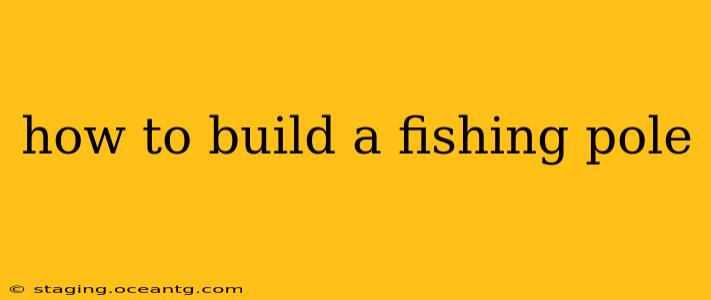How to Build a Fishing Pole: A Comprehensive Guide
Building your own fishing pole can be a rewarding experience, allowing you to customize your rod to perfectly suit your fishing style and preferences. While it might seem daunting, with the right tools and instructions, constructing a functional fishing rod is achievable. This guide will walk you through the process, answering common questions along the way.
What kind of wood is best for making a fishing rod?
The best wood for making a fishing rod depends on your desired rod characteristics – strength, flexibility, and weight. Popular choices include:
- Bamboo: Traditionally used and highly prized for its flexibility and strength-to-weight ratio. It’s relatively easy to work with but requires careful selection and preparation. Split bamboo rods are particularly renowned for their responsiveness and feel.
- Fiberglass: While not technically wood, fiberglass is a common and affordable material for rod blanks. It's strong and durable, making it a good option for beginners. Pre-made fiberglass blanks are readily available.
- Hardwoods: Certain hardwoods, like maple or ash, can be used, but they are heavier and less flexible than bamboo or fiberglass. They might be suitable for more robust applications like surf fishing.
It's important to note that finding appropriately seasoned and straight wood can be a challenge, so many beginners opt for readily available fiberglass blanks.
What are the tools I need to build a fishing pole?
The tools required will depend on your chosen materials and the complexity of your build. For a basic build using a pre-made fiberglass blank, you'll need:
- Rod blank: The core of your fishing pole.
- Guides: These direct the fishing line along the rod.
- Reel seat: This holds your fishing reel securely.
- Handle components: Cork, EVA foam, or other materials for the grip.
- Epoxy resin and hardener: For bonding the components.
- Sandpaper: For smoothing surfaces.
- Measuring tape and pencil: For accurate measurements and markings.
- Epoxy mixing cups and sticks: For preparing the resin.
- Clamps: To hold pieces together while the epoxy cures.
- Utility knife or razor blade: For trimming materials.
- Heat gun (optional): To accelerate epoxy curing (use with caution).
For a bamboo rod, you'll need additional tools for splitting, shaping, and finishing the bamboo strips.
How do I attach the guides to the rod blank?
Guide placement is crucial for smooth line flow and casting performance. The instructions provided with your guides will offer specifics, but generally:
- Plan your guide placement: Refer to a guide placement diagram if available. Spacing is generally closer together at the tip and further apart towards the reel.
- Clean the blank: Ensure the rod blank is clean and free from dust or debris.
- Apply epoxy: Apply a small amount of epoxy to the rod blank where the guide will be placed.
- Attach the guide: Securely press the guide onto the epoxy.
- Clamp and cure: Use clamps to hold the guide in place until the epoxy cures completely.
Repeat this process for each guide, ensuring they are properly aligned.
What is the best type of fishing reel to use?
The best type of fishing reel depends on your preferred fishing style and the type of fish you're targeting. Common reel types include spinning reels, baitcasting reels, and spincast reels. Each offers different advantages and disadvantages in terms of casting distance, line capacity, and ease of use. Choose a reel that’s compatible with your rod's weight and action.
How long does it take to build a fishing rod?
The time it takes to build a fishing rod can vary greatly depending on the complexity of the build, your experience level, and the materials used. A simple build using a pre-made blank might take a few hours, while a handcrafted bamboo rod could take days or even weeks. Allow ample drying time for epoxy to ensure a strong and durable rod.
Building a fishing pole is a project that rewards patience and attention to detail. By following these steps and choosing the right materials and tools, you'll be well on your way to creating a personalized fishing rod perfectly tailored to your needs. Remember to always prioritize safety when working with tools and epoxy.
